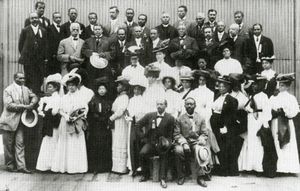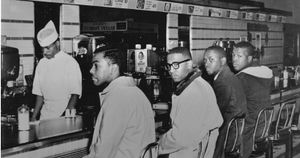How did the Civil Rights Movement Begin
The Civil Rights Movement is among the most chronicled events in African American history. It is one subject that is almost universally encountered in American history classrooms. While the general narrative of protest leading to massive changes is known, there are also many more complex stories that are often not told. One of those complex stories is the very origin of the movement itself.
Legal Contexts
As stated in What is the History of Civil Rights Legislation in the United States?, much of what constitutes “civil rights” is the requirement that all who are considered citizens be afforded both the opportunities and protections of the liberal subject. Civil rights are the basis for ensuring that the citizenry in any given society has the ability to act as citizens fairly and equally. In the United States, the legal mechanism for this is the Constitution.
With the abolition of slavery, there was the need to ensure that these protections and opportunities were extended to the freedpeople. As such, an amendment to the Constitution—the Fourteenth—was drawn up as well as a series of civil rights laws enacted by Congress. By the close of the nineteenth century, this work was undermined and new laws weakened the civil rights legislation of earlier periods. In their stead, Jim Crow, a form of legal segregation and the direct opposite of formal equality, began its ascent.
Origins of the Legal Battle
Almost immediately, Black activists began to battle for the restoration of their civil rights. In Defining the Struggle, Susan Carle argues that this began in the 1880s with groups like the Afro-American League, under the leadership of Howard Law School graduate, T. Thomas Fortune, pressuring the state through legal test cases. The strategy was to utilize incidents of racial discrimination as “tests” to bring to the courts to get them to rule on the legality of segregation. In the 1890s, another organization, the Afro-American Council continued this strategy. However, with the Plessy v. Ferguson decision of 1896, it seemed things would get a bit more difficult.
Early Twentieth Century Movements
Plessy might be understood amid the strategies of Booker T. Washington and the Tuskegee Machine. In his famous speech a year before the legal case, known as the “Atlanta Compromise,” Washington argued that social agitation for rights should be pushed to the side in favor of separate development. It immediately allowed him access to philanthropic funds, gained the purchase of many Southern leaders and Tuskegee University became a model for Black institutions in the South. But some Black leaders retorted that the question of rights should not be subordinated to separate development of the races and that rights were required to make that development happen.
Those who believed that Washington’s program was flawed continued to organize using the model of the test case. Many of the lawyers in the Black community joined their work to formations like the Afro-American Council and won many important victories for desegregation of public accommodations throughout the country. This strategy was followed by the Niagara Movement, which emerged to oppose the political tactic of the Tuskegee Machine in 1905. Their “Declaration of Principles” essentially affirmed their alignment with the civil rights struggles of the past and foreshadowed the future.
The Founding of the National Association for the Advancement of Colored People
In 1909, the National Association for the Advancement of Colored People (NAACP) was founded amid the outcry and fallout from the Springfield Race Riot in 1908. A collection of moderate white liberals, the group was fused out of the settlement house movement and American progressivism. They felt strongly that progress would be made by appealing to the inherent morality of the nation and getting it to see that racism was an impediment to human flourishing. Equality, it was understood, was foundational to the nation and could only be made real with the advancement of Black people.
W.E.B. Du Bois was invited to join the group as editor of The Crisis, the NAACP’s main organ. Du Bois had been part of the Afro-American Council and the Niagara Movement. Eventually, the NAACP would begin to adopt many of the legal strategies that these groups had pioneered. In addition to confronting the issue of lynching, the organization developed a legal arm that would begin to undermine the legal foundations of Jim Crow. Pioneered by Howard University School of Law dean, Charles Hamilton Houston, the Legal Defense Fund began a long assault on segregation.
School Desegregation
The Legal Defense Fund began its work in the 1930s and looked toward desegregating professional schools as a way to confront the environment of Jim Crow. It was believed that opening doors for Blacks in these settings would allow the expansion of Black professionals that would then serve the Black community. In a series of cases, they were able to undo the segregationist policies of law schools in Maryland (Murray v. Maryland), Missouri (State ex rel. Gaines v. Canada), and eventually Oklahoma (McLaurin v. Oklahoma) and Texas (Sweatt v. Painter).
All the while, the desegregation of public school resources was on the agenda. Houston passed away in 1950, leaving the work to a group of young attorneys, including eventual Supreme Court justice, Thurgood Marshall. Together, they led the legal strategy that eventuated in the school desegregation case, Brown v. Board of Education. A collection of five cases of educational discrimination and inequality from around the country, the strategy pivoted on demonstrating that segregation was inherently unequal, which demanded the remedy that there should not be two separate school systems. Their argument won and on May 17, 1954, the Court declared segregation unconstitutional. A year later, the Court demanded, however, that integration could proceed with “all deliberate speed.” This meant that integration would not be immediate.
The Origins of Direct Action
In order to make civil rights a reality, more than the legal shift had to occur. Direct action was seen as a way of making an opening and pressuring the government to ensure that the laws on the books were changed and then enforced, providing the ultimate protections of Black citizenship. Among the most effective targets for direct action were public accommodations, and those spaces that received the earliest moments of civil rights agitation were public transportation. The “right to ride,” as framed by historian Blair L.M. Kelley, was critical for it allowed the vast majority of Black people to be able to navigate the cities and towns where they often worked, many times in white neighborhoods. The irony is that residential segregation provided the context for the need for desegregation of public transportation. Black people were forced into the backs of buses and trains, and in the cases of interstate travel, they were relegated to the Jim Crow car. It was a source of both shame and denigration and deeply inconvenient, if not absurd.
While the 1956 Montgomery Bus Boycott is an important case study of these issues, with the indigenous leadership, the national attention, and the eventual Supreme Court case as key nodes, there is a long history of public transportation direct action work as well as boycotts that preceded it and set the stage. An influential one was the Baton Rouge Bus Boycott of 1953. Much of this work can be traced to the 1940s, with institutions like the Highlander school, providing training to those would eventually take up the struggle. It was at Highlander where Rosa Parks, the heroine of the Montgomery Bus Boycott was trained.
Even in cities like Montgomery, there were previous attempts to raise this question and what it demonstrated was that people were thinking about these questions and seeking solutions long before the national attention of the late 1950s. Out of these moments, Black churches, became the base for much of civil rights activity throughout the south, ministers like Martin Luther King, Jr. were then thrust into the leadership positions that they were known for during the period. But without the spark of ordinary people, they would not have had anyone to lead. With the Freedom Rides, young activists began to take center stage on these questions. By the 1960s, they would be firmly ensconced in the movement.
Young Activists and Civil Rights
Providing a new spark and energy to the tradition of direct action, young activists during the early 1960s helped expose the nation to the evils of segregation executing a number of sit-ins that made public accommodations a key issue in the fight for civil rights. These students were products of complex histories. One group of students was Southern-born and bred and came to the movement out of a deep antipathy for the environments that fostered the hate that underpinned segregation. They were the products of the inadequate schools, their parents were the laborers who were cheated out of economic opportunity. But in 1955, when Emmett Till was murdered in Mississippi, they felt the call to do something. Calling themselves, “The Emmett Till generation,” they joined their local NAACPs and many of them attended local HBCUs and used those spaces as the launching pad for the sit-in movement.
Another group came to the movement from the north. They were Black and experienced levels of poverty and dispossession but did not experience Jim Crow in the same way until they came south to attend college. Many of them, however, did come with a previous understanding of socialism and pacifism and other radical ideologies that they picked up from various Northern environments. They saw ways to immediately apply these tactics to the Southern struggle.
The fusion of these two groups created a prime opportunity to develop a national struggle. After the Greensboro Four, sparked a new wave of sit-ins on February 1, 1960, Black students across the nation begin to emulate their example. Seeing the need to organize this fervor, longtime activist and current organizer of the Southern Christian Leadership Conference, Ella J. Baker sent out a call for a meeting on Easter Weekend. The result of that call was the creation of the Student Nonviolent Coordinating Committee.
Conclusion
The Civil Rights Movement began because of the need for ordinary people to realize and enact their own definitions of freedom. In order for such a movement to occur, their activity had to precede any attempt to organize or provide the legal language necessary for effecting change. That process is not limited to the moments that are often narrated in school textbooks, and those moments themselves must be contextualized as belonging to that process. With the history of the legal struggle for civil rights and the history of direct action, as well as those struggles for self-defense and against sexual assault, we can better understand the origins of the Civil Rights movement.
Bibliography
Susan Carle, Defining the Struggle: National Organizing for Racial Justice, 1880-1915 (New York: Oxford University Press, 2013)
Rawn James, Root and Branch: Charles Hamilton Houston, Thurgood Marshall, and the Struggle to End Segregation (New York: Bloomsbury Press, 2013)
Blair L.M. Kelley, Right to Ride: Streetcar Boycotts and African American Citizenship in the Era of Plessy V. Ferguson (Chapel Hill, NC: University of North Carolina Press, 2010)
Wesley Hogan, Many Minds, One Heart: SNCC's Dream for a New America (Chapel Hill, NC: University of North Carolina Press, 2007).


